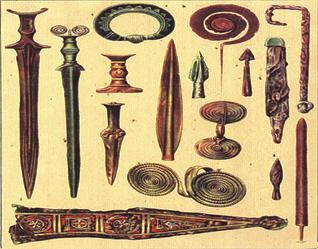Stamp: Iron age - top imperf (Sweden 1967)
Iron age - top imperf (Sweden 1967)
17 May (Sweden ) within release Iron Age goes into circulation Stamp Iron age - top imperf face value 15 Swedish öre
| Stamp Iron age - top imperf in catalogues | |
|---|---|
| Michel: | Mi:SE 581Do |
| Stamp Number: | Sn:SE 728 |
| Unificato: | Un:SE 564 |
Stamp is square format.
Also existing cut lower sideAlso in the issue Iron Age:
- Stamp - Iron age - top imperf face value 10;
- Stamp - Iron age - top imperf face value 15;
- Stamp - Iron age - top imperf face value 30;
- Stamp - Iron age - bottom imperf face value 30;
- Stamp - Iron age - bottom imperf face value 35;
- Stamp - Iron age - bottom imperf face value 10;
- Stamp - Iron age - bottom imperf face value 15;
- Stamp - Iron age - top imperf face value 35;
- Se-tenant - Man holding a fettered bear face value 2*10;
- Se-tenant - Warrior disquised to a wolf face value 2*30;
- Se-tenant - Helmet-crested warriors face value 2*35;
- Se-tenant - Man fighting bears face value 2*15;
- Booklet - Iron age face value 200;
- Booklet - Iron age face value 2;
- Booklet Pane - Iron age face value 200;
|
Data entry completed
56%
|
|
|---|---|
| Stamp Iron age - top imperf in digits | |
| Country: | Sweden |
| Date: | 1967-05-17 |
| Perforation: | 12¾ |
| Emission: | Definitive |
| Format: | Stamp |
| Face Value: | 15 Swedish öre |
| Print run: | 8782000 |
Stamp Iron age - top imperf it reflects the thematic directions:
Mammals are any vertebrates within the class Mammalia (/məˈmeɪli.ə/ from Latin mamma "breast"), a clade of endothermic amniotes distinguished from reptiles (including birds) by the possession of a neocortex (a region of the brain), hair, three middle ear bones and mammary glands. All female mammals nurse their young with milk, secreted from the mammary glands. Mammals include the largest animals on the planet, the great whales. The basic body type is a terrestrial quadruped, but some mammals are adapted for life at sea, in the air, in trees, underground or on two legs. The largest group of mammals, the placentals, have a placenta, which enables the feeding of the fetus during gestation. Mammals range in size from the 30–40 mm (1.2–1.6 in) bumblebee bat to the 30-meter (98 ft) blue whale. With the exception of the five species of monotreme (egg-laying mammals), all modern mammals give birth to live young. Most mammals, including the six most species-rich orders, belong to the placental group. The largest orders are the rodents, bats and Soricomorpha (shrews and allies). The next three biggest orders, depending on the biological classification scheme used, are the Primates (apes and monkeys), the Cetartiodactyla (whales and even-toed ungulates), and the Carnivora (cats, dogs, seals, and allies).
Bears are carnivoran mammals of the family Ursidae (/ˈɜːrsɪdiː, -daɪ/). They are classified as caniforms, or doglike carnivorans. Although only eight species of bears are extant, they are widespread, appearing in a wide variety of habitats throughout most of the Northern Hemisphere and partially in the Southern Hemisphere. Bears are found on the continents of North America, South America, and Eurasia. Common characteristics of modern bears include large bodies with stocky legs, long snouts, small rounded ears, shaggy hair, plantigrade paws with five nonretractile claws, and short tails.
The Bronze Age is an anthropological archaeological term defining a phase in the development of material culture among ancient societies in Asia, the Near East and Europe. An ancient civilisation is deemed to be part of the Bronze Age if it either produced bronze by smelting its own copper and alloying it with tin, arsenic, or other metals, or traded other items for bronze from producing areas elsewhere. The Bronze Age is the middle principal period of the three-age system, following the Stone Age and preceding the Iron Age. Conceived as a global era, the Bronze Age follows the Neolithic ("New Stone") period, with a transition period between the two known as the Chalcolithic ("Copper-Stone") Age. These technical developments took place at different times in different places, and therefore each region's history is framed by a different chronological system
Animals are multicellular, eukaryotic organisms of the kingdom Animalia (also called Metazoa). All animals are motile, meaning they can move spontaneously and independently, at some point in their lives. Their body plan eventually becomes fixed as they develop, although some undergo a process of metamorphosis later on in their lives. All animals are heterotrophs: they must ingest other organisms or their products for sustenance.
An anniversary is the date on which an event took place or an institution was founded in a previous year, and may also refer to the commemoration or celebration of that event. For example, the first event is the initial occurrence or, if planned, the inaugural of the event. One year later would be the first anniversary of that event. The word was first used for Catholic feasts to commemorate saints. Most countries celebrate national anniversaries, typically called national days. These could be the date of independence of the nation or the adoption of a new constitution or form of government. The important dates in a sitting monarch's reign may also be commemorated, an event often referred to as a "Jubilee".





